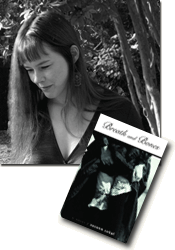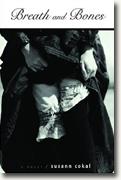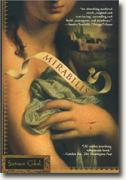Once in Colorado, Famke realizes she is safer disguised as a man, a drastic change for such a woman. Was this change in appearance more beneficial than detrimental?
Definitely. It would have been impossible for her to move around the West the way she does if she weren’t disguised as a man. She’s a good mimic, so she can pull it off. Myrtice, the novel’s other “virtuous” woman Famke’s age, could never manage it; that’s why she needs Viggo’s protection as she travels.
Famke's short life is essentially sad, but she touches those she knows indelibly, Viggo, Sister Birgit, Mr. Goodhouse, Edouard Versailles. Isn't there something innately appealing about this young protagonist?
I hope so—that’s what should keep people reading! In the world of the novel, of course, there is Famke’s beauty, and then that desire for love that I think draws people to her. She’s awfully selfish, but I don’t think she has bad intentions.
Famke is hungry for more than the world has to offer a woman of her station from the beginning, eagerly biting the glass of her infant's feeding bottle. Can you speak to the symbolism of the broken glass cutting her lips, the blood she coughs up and her belief that being with Albert will heal her of the disease?
In our culture, it’s traditional to associate being in love with having a disease—we say we’re lovesick, we’re suffering from love, we feel passion (which can mean strong emotion or strong pain and suffering). In many novels, someone with “a heart condition” is not only physically weak but also susceptible to lovesickness (I’m thinking particularly of Ford Madox Ford’s The Good Soldier). Coughing up blood is, in a sense, akin to wearing your heart on your sleeve. As to the symbolism of the broken glass nipple—I think I’d like to leave that one open to interpretation.
Edouard Versailles is a doctor of the times, inventing a "cure" for a malady of the lungs that uses electricity to stimulate healing. Is there ever a better time for doctors and their so-called machines, before the practice of medicine is governed by rules and regulations? And aren't these men especially adept at "cures" for women's problems?
In the second half of the nineteenth century, producing “hysterical crises” in women’s sexual parts became a great medical industry. Doctors did it first manually, then decided that technique wasn’t genteel enough, so they started inventing all kinds of machines. It was the era of the medicine show and the snake oil salesman, so yes—a great time to be practicing medicine freely. And if the orgasm cure seems quaint, just look at any recent issue of Cosmopolitan magazine; some of us still seem to believe that having an orgasm will cure all manner of problems, from depression to bad skin.
Other than Alfred, every man that Famke meets literally wants to keep her. How does her position of dependency illustrate the plight of women in the rigid 19th-century society?
Women of the time did depend, almost universally, on their menfolk for a public and legitimate identity. Famke manages a little more freedom than that, because she is truly creative about the way she lives her life. But men did expect to keep the women they loved, and in some way every man she meets (except, perhaps, Viggo) sees Famke as a kind of object to be hoarded up.
Albert Castle disdains the Impressionists, holding to the old school philosophy of the Pre-Raphaelite Brotherhood. Yet in America, the quality of his work deteriorates rapidly. What happens to all his good intentions? Is Famke the missing ingredient?
She certainly thinks she is! The sad truth is that Albert is not a very good painter, and in any event the heyday of the Pre-Raphaelites is past when he tries to join up. In America, he decides to paint for money for a while—always a bad reason to produce art, as the art quickly becomes something else that way. He believes he still has great artistry in him, but I think the reader knows better.
You write of blood on Famke's lips as a baby, coughed from her lungs, on her chemise as she poses. Is this blood symbolic of female sexuality? Why/why not?
I don’t really like to comment on my own use of symbolism, but it is true that women are traditionally associated with blood and water and other flowing substances—obvious reasons, of course. In the nineteenth century, over 90 percent of the population was host to the tuberculosis bacillus, whether they were showing symptoms of the disease or not. And tubercular women were considered sexy—their body temperature went up, their skin got very white, their cheeks very red (the “hectic flush”), and their eyes bright. They were literally hot to the touch.
With pollution and other problems, everyone coughed. In general, it was a bloodier time.
Then there are the other substances, Viggo's embalming fluid, Albert's paints, Edouard's "galvanic invention". Are all of these symbolic of the ebb and flow of life? Why/ why not?
I think life mostly ebbs in this novel. And when people feel most passionate, in some sense they are closest to death.
In Hygeia, tuberculosis sufferers are so numerous that they are referred to as "lungers". What is the mortality rate for those with the disease at that time? Is there ever any hope for them?
“Lungers” was a common term—for people whose lives had been taken over by their lungs. The survival rate is hard to pin down, but in 1890 there were approximately 280 deaths from tuberculosis per 100,000 persons living in the United States.
Why did you begin your novel in Denmark and then bring Famke all the way to America and through the West?
I did that partly because my mother was Danish, and I was writing this story somewhat from that sense of loss during my parents’ illnesses and deaths. I love Denmark; it’s always been a magical place full of spires and green copper roofs, swans, castles, and really delicious cakes. Also, we in America don’t see too many novels set partly in Scandinavia. But this was always primarily an American novel, showing how immigrants might have adapted, how people were constantly on the move, constantly changing their identities.
Edouard Versailles is as reserved as a Victorian maiden. Why is he so out of tune with his physicality? Is this a common problem for men of his position and wealth?
He’s in part what the literary historians call a Man of Sentiment—more of an eighteenth-century phenomenon—and he’s also dedicated to the nineteenth-century cult of mourning (his parents died, one of consumption and one of grief, and he can’t quite forgive himself for surviving). So even as he’s moving into the future with his medical inventions, he’s stuck in the past; and even as he tries to focus on the body, he can’t get away from his emotions. Class and wealth give him the leisure to devote himself to his feelings.
Famke puts enormous energy into locating her beloved Albert. What will happen if reality doesn't live up to her dreams? Or is she too focused on surviving to even consider the outcome of her search?
How can reality ever match up to our dreams? But of course we have the dreams because we can’t stop hoping … Actually, last night I was watching some dancers with a friend of mine, who said, “Now reality has spoiled the fantasy.” I suppose the biggest hope is always that reality will be even greater than fantasy.
Are you currently working on another project? If so, can you share something about it with us?
Yes, I’m working on a new novel. It’s set during the Renaissance, in a Scandinavian island country I’m making up. I have to invent a country because this time I want to write about the ruling family; the queen has a mental disorder that affects the country’s well-being.
Do you have any advice for aspiring writers?
I think the best advice I can give is for people to ask themselves why they’re writing. If you want to write for readers, you should find a group of people—a class or a more informal writing group—who will read and critique your work. If you want to write for yourself, that’s fine too. Whatever you do, you should work on something you really love and care about; life is too short to spend it on art you don’t enjoy.



